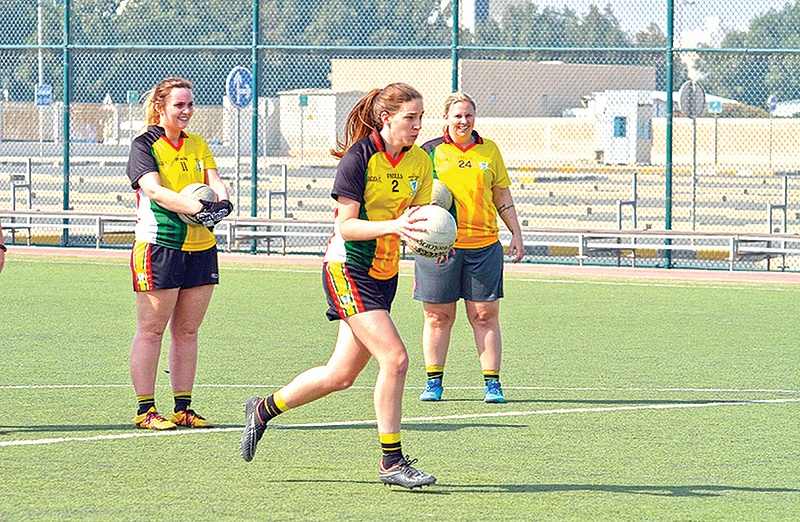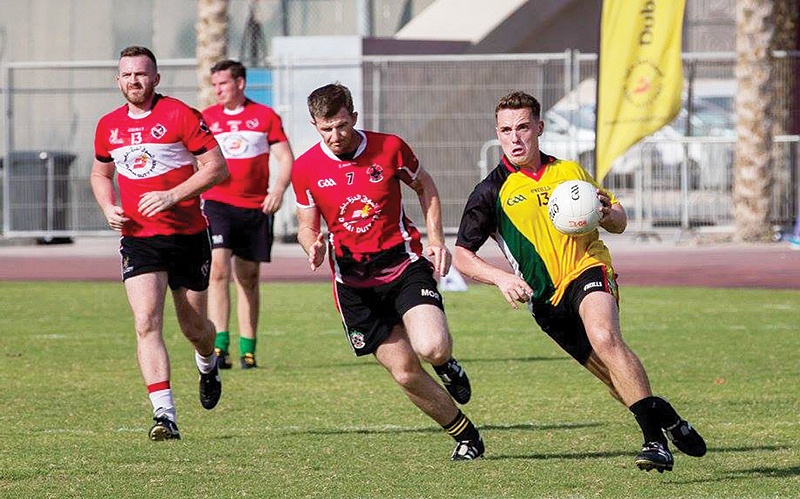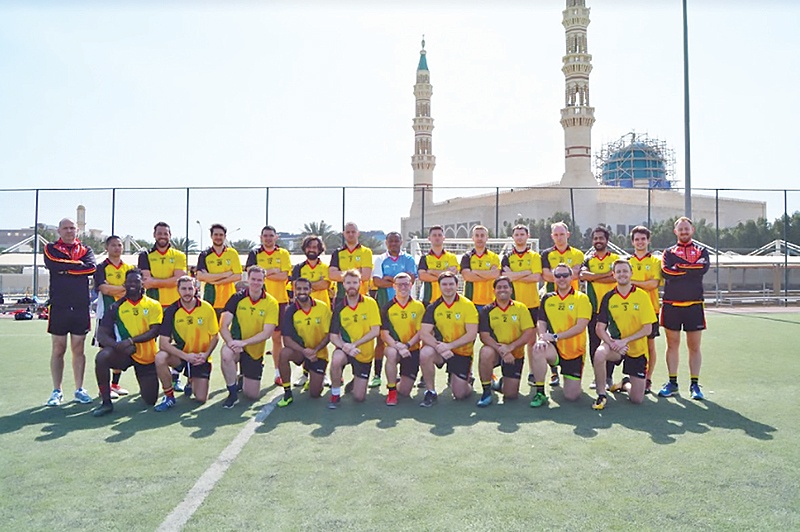'Gaelic football combines skills of soccer, scores of basketball with rough and tumble of rugby.'

The suspense and skill of soccer, the high scoring of basketball and the impact of rugby can all be found in Gaelic football, a popular sport in Ireland.
Kuwait Times spoke with Chelsea Ellis, Chairperson of Kuwait Harps, the only Gaelic Athletic Association (GAA) club in Kuwait, to learn more about the sport.
Ellis is originally from Michigan, USA, she moved to Kuwait in 2010. She joined the Kuwait Harps in 2013 having never even heard of the sport before and has been playing with them ever since. This is Chelsea's second year as club chairperson. She looks forward to the season ahead and the success of the Kuwait Harps in the Middle East league.

Kuwait Times: What is Gaelic football? Where did Gaelic football originate?
Chelsea Ellis: Gaelic football is a field sport with Irish heritage that combines the skill of traditional football with elements of basketball, volleyball and Australian football. Originating in Ireland, Gaelic football quickly gained in popularity in the last few years with competitions now held throughout the globe. Ladies' Gaelic football, in particular, is recognized as one of the fastest growing female sports in Europe.
KT: What is the difference between Gaelic football and regular football?
Ellis: The biggest difference is that you can use your hands in Gaelic football, and because of this, there are many differences in gameplay and scoring. Gaelic football does contain some familiar elements of soccer, such as the ability to kick the ball and scoring by getting the ball into the net. Another big difference is that Gaelic sports at all levels are considered amateur, meaning that all athletes, even those competing at the highest level, do not receive any payment for playing.

KT: How do you play it? What are the rules?
Ellis: There are many intricacies to the sport of Gaelic football, but the main rules are as follows:
- In the Middle East league, the games consist of two seven-minute halves. The games are played nine-a-side (eight outfield and one goalkeeper).
- The ball can be carried in the hand for a distance of four steps before the player must either pass the ball to another player, solo or bounce the ball.
- The ball can be passed to another player by either kicking the ball or "hand-passing", which is a striking motion with the hand or fist (no throwing the ball).
- After every four steps the ball must either be bounced or "soloed", an action of dropping the ball onto the foot and kicking it back into the hand.
- You may not bounce the ball twice in a row.
- Players in the men's league may not lift the ball directly from the ground. The toe may be used to lift the ball from the ground into the hands. However, in ladies' Gaelic football, the ball may be picked up directly.
KT: What is the aim of Gaelic football?
Ellis: The main aim is to score points and goals. Gaelic football is played with a goal (similar to football) that has goalposts (similar to rugby) fixed on either side. A point is scored by kicking or hand passing the ball between the posts and above the goal crossbar. A goal is scored by playing the ball between the posts and below the crossbar and is worth three points.
KT: What does a black card in Gaelic football mean?
Ellis: A black card in Gaelic football is similar to a red card in soccer; however, receiving a black card will result in a player being sent off and replaced by a substitute. A black card is given for "cynical behavior" fouls such as deliberately tripping another player or verbally abusing a match official.
KT: Is Gaelic football older than soccer?
Ellis: The Gaelic Athletic Association was founded in 1884, while contemporary football began in England in 1863. Although slightly younger than soccer, it is older than many sports such as American football and basketball.
KT: When did you start playing Gaelic football in Kuwait?
Ellis: The Kuwait Harps were originally founded in 1997, but the club was disbanded in the early 2000s. The club was reestablished in 2011 with a men's team, and 2012 saw the addition of a women's team for the first time.
KT: How many players are in your team?
Ellis: Club membership is at an all-time high, with more than 70 members in the club. It's an even split with about half of the members on the men's team and the other half on the women's team.
KT: Is it open to the public? Does it include men, women or children?
Ellis: We are open to anyone 21 years and older and we are always welcoming new members regardless of experience or skill level. Our players come from all over the world, and for a lot of Kuwait Harps, when they joined the team it was their first time kicking a Gaelic football. The Kuwait Harps have both a women's team and men's team and offers separate training sessions for each team.
While we do not currently have a youth team, we offer youth days throughout the year to teach school-age children about the sport and hold tournaments for them to compete in. We also provide equipment and resources to various schools in Kuwait so they can teach Gaelic football in PE lessons, or offer afterschool clubs. For more information regarding our youth development program, please contact [email protected]

KT: Do you have tournaments? Who do you play against?
Ellis: The Kuwait Harps are affiliated with the Middle East county board and participate in the Middle East Gaelic Football League, comprised of other teams from GCC countries. Tournaments attended by the Kuwait Harps include the Bahrain Irish Festival, the Dubai Duty Free Gaelic Games and tournaments in Oman, Abu Dhabi, Sharjah, Al Ain and Qatar. We occasionally have the chance to travel to tournaments outside the Middle East, such as the Asian Gaelic Games in Malaysia and the World Games in Ireland. The Kuwait Harps have won several titles through the years and won in many divisions such as the Asian Gaelic Games, Men's Intermediate Championships and Ladies' Intermediate Division Champions, to name a few.
KT: What are the main benefits of playing?
Ellis: We are a club focused on providing superb training and skills in the field of Gaelic football. In conjunction to this, the Kuwait Harps Club is a social outlet for those new and old to Kuwait with social events, tournaments, training sessions and outings throughout the year. New players are always welcome and immediately feel at home within the club. Most of our current squads were new to Gaelic Games when they first came to our training sessions and have been welcomed with open arms.
While many clubs in the Gulf region can depend on a strong pool of Irish players, this is not the case in Kuwait. There are currently over 70 players in the club, with over 12 countries represented. Included on our player panel are several local Kuwaiti players as well as players from Ireland, Scotland, England, Wales, Spain, Egypt, India, Canada, USA, Australia, Sudan and Somalia. The wide diversity of player nationalities demonstrates the global appeal of this game in Kuwait, something that we as a club are very proud of.
The Kuwait Harps GAA club holds weekly training sessions for both men and women on Tuesdays from 6pm to 8 pm at American International School and Fridays from 10 am to 12noon at Juventus Academy in West Mishref. Our season runs from September through May and we are always open to new players! Stop by one of our training sessions, or send a message to [email protected] for more info or check us out on Instagram @kuwait_harps_gaa
By Faten Omar










